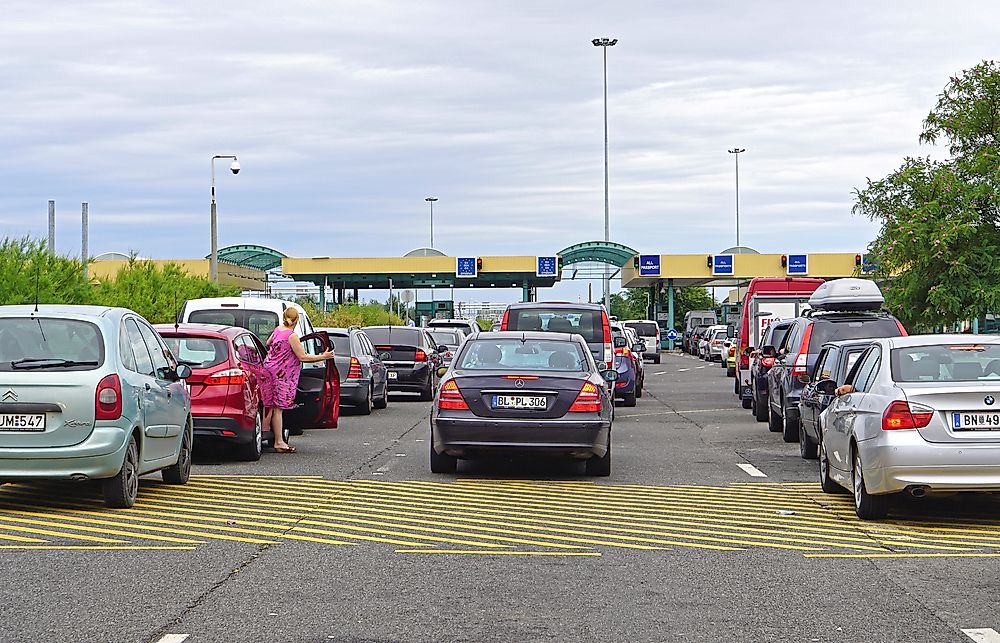Which Countries Border Hungary?

Hungary is a country found in Central Europe. Archaeologists have found evidence that several communities lived within Hungary's borders as early as 6000 BC. During the long period since the first communities set up homes in Hungary, the boundaries of Hungary have gone through many dramatic changes. Some kingdoms exerted their influence within Hungary's borders such as the Roman Empire, the Ostrogothic kingdom, and the Hunnic Empire. During the 19th century one of the most influential kingdoms in Hungary's history was established, the Austro-Hungarian Empire. Hungary today borders Slovenia, Ukraine, Austria, Croatia, Romania, Serbia, and Slovakia.
Hungary-Slovenia Border
Hungary's shortest border is the 63-mile boundary that separates it from Slovenia. The border is situated on the western edge of the country, and like the rest of Hungary's borders, it was determined after the First World War. On the Hungarian side of the border, there are several important towns such as Redics and Csesztreg. Due to their proximity, Slovenia and Hungary have a unique relationship. Demographic estimates indicate there are nearly 3,000 ethnic Slovenes in Hungary while nearly 7,700 ethnic Hungarians make their home in Slovenia. Another factor that improves the ties between the two nations is the fact that they both have a diplomatic mission within the other's borders. In Slovenia, the Hungarian government is represented by an embassy situated in Ljubljana. On the other hand, in Hungary, the Slovenian government is represented by an embassy located in Budapest as well as a consulate general within Szentgotthárd.
Hungary-Ukraine Border
The boundary that separates Hungary and Ukraine is roughly 64 miles long and is located in the Northeastern region of the country. The most important town located on the Hungarian side of the border is Kisvarda, and a railway passes through it lining the city to Ukraine. Data indicates that approximately 157,000 Hungarians are living within Ukraine's borders. The large number of Hungarians in Ukraine is attributed to the fact that the Zakarpattia region was once part of Hungary. Even though the laws of Ukraine do not recognize dual citizenship, a significant number of Hungarians in Ukraine hold both Hungarian and Ukrainian citizenship. Hungary and Ukraine have close diplomatic ties with the Ukrainian government being represented by an embassy located in Budapest as well as a consulate general within Nyíregyháza. On the other hand, the Hungarian government has four representations in Ukraine: an embassy in the capital Kiev, a consulate located in Berehove, a consulate general located in Uzhhorod as well as an honorary consulate situated in Lviv
Hungary-Austria Border
The border that separates Austria and Hungary is approximately 200 miles long and is situated in the northwestern section of the country. One of the important natural features along the border between the two nations is Lake Neusiedl. There are also some towns along the Hungarian side of the border such as Szombathely and Soproh. A railway line exists connecting various Hungarian towns and Austrian towns. The ties between the two nations date back to the period of the Austro-Hungarian Empire. In the modern period, Austria and Hungary have close diplomatic ties that were established in 1921 after the two nations were forced to split.
Hungary-Croatia Border
The boundary that separates Croatia and Hungary is roughly 216 miles long and is situated in Hungary's southwestern section. The Drava River forms a significant portion of the boundary between Croatia and Hungary. There are roughly 16,600 Hungarians who call Croatia home while roughly 15,600 Croatians are living within Hungary's borders. Due to their close ties, the Croatian and Hungarian governments work together in many fields such as economic and infrastructural development. Other sectors where the two governments work together include scientific development, cultural exchange, and trade.
Hungary-Romania Border
The boundary that separates Romania and Hungary is roughly 263 miles long and is situated in the eastern section of the country. Several towns are situated along the border on the Hungarian side such as Sarkad, Gyula, and Veezto. Historical evidence indicates that the ties between the two nations date back to the Middle Ages when several sections of Romanian territory such as Banat, Crişana and Transylvania were under the control of the Hungarians. The modern-day ties between the two nations include close diplomatic and economic relations. Romania and Hungary are both members of several international organizations such as NATO and the European Union which improves their bilateral ties.
Hungary-Serbia Border
The boundary that separates Serbia and Hungary is approximately 102 miles long and is situated in the southern section of the country. On the Hungarian side, the towns situated along this section of the border include Siklos, Mohacs, Baja, and Bacaalmaa. The ties between Serbia and Hungary date back to the 19th century, particularly in 1882, when they were formally established between the nation of Serbia and the Austro-Hungarian Empire. The modern-day ties between Serbia and Hungary include close diplomatic and economic ties. There is also a significant population of Hungarians, roughly 254,000 according to some estimates, living in Serbia. On the other hand, a relatively low number of Serbians live in Hungary, roughly 7,000.
Hungary-Slovakia Border
Hungary's longest land border is the one that separates the country from Slovakia which is roughly 390 miles long on the northern edge of Hungary. For a significant portion of time, much of Slovakia's territory was part of Hungary's land. Historical evidence indicates that there have been two major periods of diplomatic ties between Slovakia and Hungary in recent times. The first period began in 1939 and lasted until 1945 while the second period began in 1993 after Slovakia attained its independence from Czechoslovakia. In Hungary, the Slovakian government is represented by an embassy situated in Budapest as well as a consulate general situated in Békéscsaba. On the other hand, the Hungarian government in Slovakia is represented by an embassy located in Bratislava as well as a consulate general situated in Kosice.











